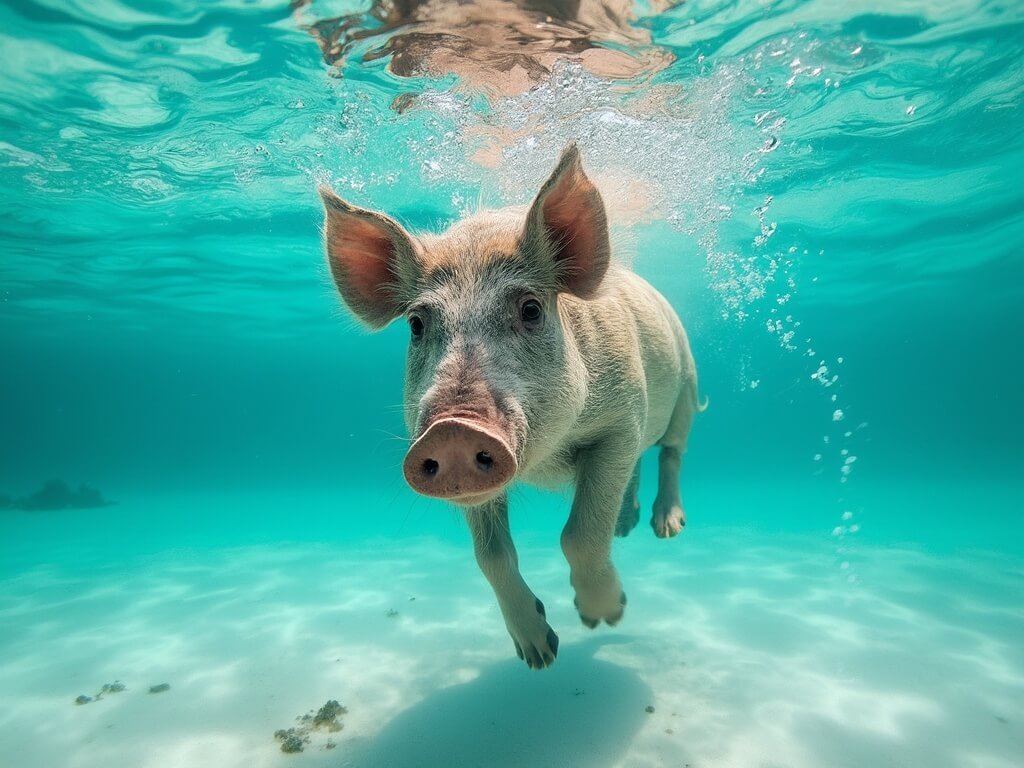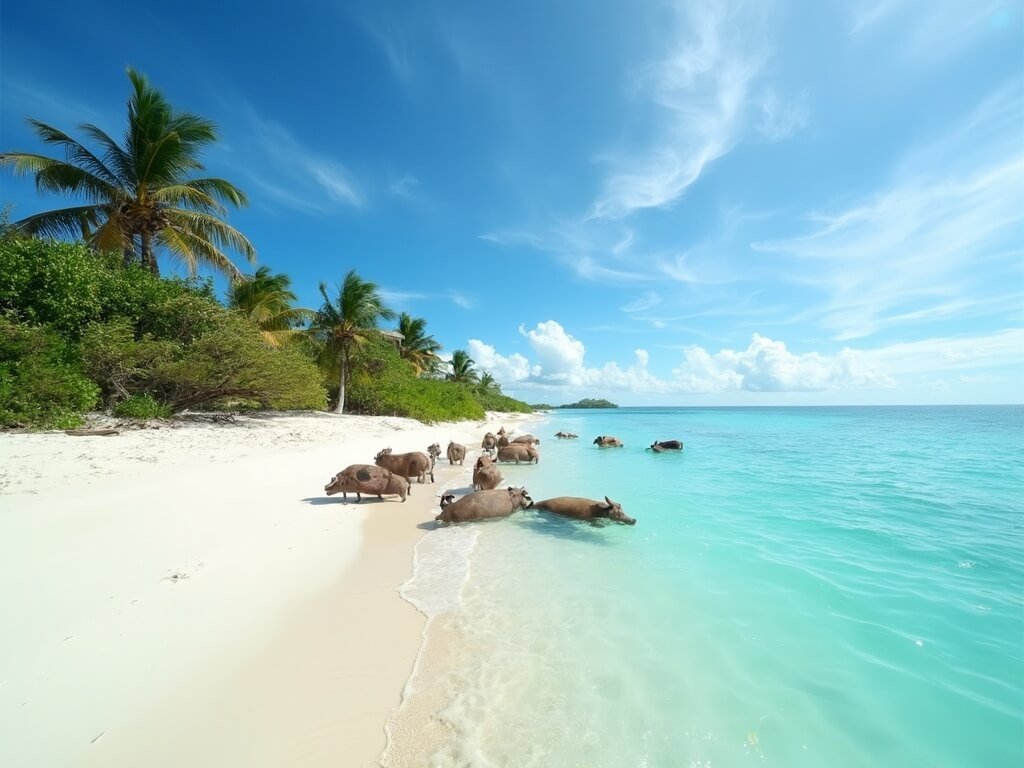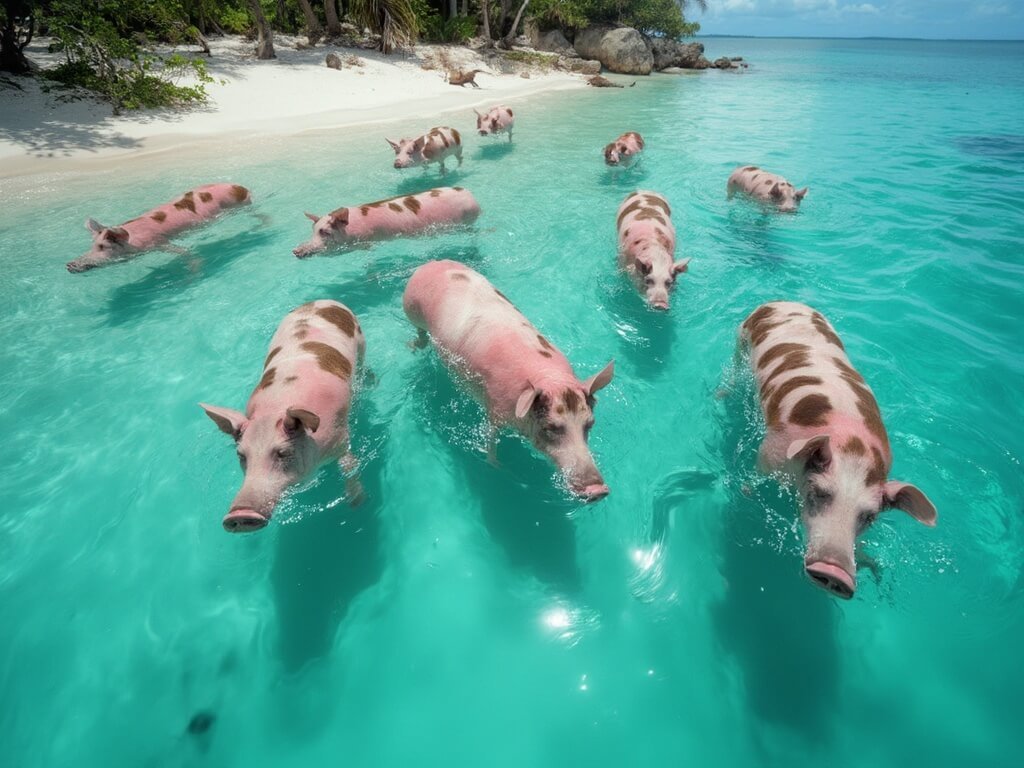Ever wondered what it’s like to splash around with adorable swimming pigs in crystal-clear turquoise waters? The Bahamas offers one of the most unique wildlife encounters on the planet.
Swimming pigs have transformed from a quirky local legend into a global tourism phenomenon that’s captured imaginations worldwide. These charismatic swimmers aren’t just a cute attraction – they’re a full-blown Caribbean experience that’s become bucket list material for travelers.

The Unexpected Origins of Bahamas’ Swimming Pigs
Picture this: An uninhabited island in the Exuma archipelago, where wild pigs roam freely, swimming out to greet boats like they’re welcoming VIP guests. Big Major Cay – aka “Pig Beach” – is where this incredible story began.
How did pigs end up on a tropical island? The theories are deliciously mysterious:
- Some say sailors left them as a potential food source
- Others claim local farmers introduced them
- A few romantic souls believe they survived a shipwreck
Whatever the truth, these pigs have become international celebrities.
Where Can You Actually Swim with Pigs?
While Big Major Cay remains the OG pig swimming destination, several Bahamian islands now offer similar experiences:
- Big Major Cay (Pig Beach): The original and most famous location
- Rose Island: Near Nassau, with pigs raised specifically for tourist interactions
- Meeks Patch Island: Features pigs alongside other adorable animals
- Ship Channel Cay: Offers localized pig encounters
Pro tip: Big Major Cay remains the most authentic experience. Other locations are essentially trying to replicate its magic.
What to Expect During Your Pig Swimming Adventure
Most tours follow a similar blueprint:
- Boat trip from nearby islands
- 1–2 hours of pig interaction
- Combination with other attractions like:
- Thunderbolt Grotto exploration
- Iguana Beach visits
- Nurse shark swimming
The pigs themselves are the real stars. They’ll literally swim out to meet boats, hoping for treats and attention. Imagine wild pigs paddling towards you in bright blue water – it’s surreal.
A Personal Pig Encounter
During my own Bahamas trip, I watched a baby pig – couldn’t have been more than weeks old – awkwardly swimming towards our boat. His determined little snout cutting through the water was both hilarious and heartwarming.
The piglet’s confidence, despite clearly being a novice swimmer, epitomized the charm of this entire experience. These aren’t just animals – they’re personalities with fins.
Critical Considerations: Animal Welfare Matters
Not all pig swimming experiences are created equal. Responsible travelers should:
- Choose tour operators committed to animal welfare
- Bring appropriate treats (fresh fruits)
- Avoid overwhelming or stressing the animals
- Respect their natural environment
A dedicated caretaking committee now oversees the pigs’ health, ensuring regular veterinary check-ups and maintaining a nursery for piglets.
When and How to Plan Your Pig Swimming Trip
Best Seasons:
- December to April (dry season, calm seas)
- Avoid hurricane season (June–November)
Typical Tour Details:
- 1.5–6 hours total experience
- Prices vary by group size and boat type
- Options include day trips, private charters, cruise excursions
The swimming pigs have become more than a tourist attraction – they’re a symbol of the Bahamas’ playful, unexpected magic. As tourism evolves, these paddling porkers continue capturing global imagination.
Your crystal-clear waters and swimming pig adventure awaits. The only question is: Are you ready to dive in?
Related Adventures You Might Enjoy
The Economics of Pig Tourism: A Surprising Caribbean Success Story
Every successful tourism phenomenon has an economic heartbeat, and the swimming pigs are no exception.
Local island economies have transformed these adorable swimmers into genuine cash cows – or should I say, cash pigs? Small communities that once struggled economically now see thousands of visitors annually, all eager to splash with their porcine celebrities.
Tour operators typically charge between $150-$300 per person for pig swimming experiences. With boats running multiple trips daily during peak season, we’re talking serious revenue generation for these tiny Bahamian islands.
Hidden Costs: The Real Price of Popularity
But popularity comes with challenges:
- Increased tourist traffic strains local ecosystems
- Risk of over-commercializing authentic experiences
- Potential animal welfare concerns
During my last visit, I spoke with a local tour guide who candidly shared concerns about maintaining the authenticity of these encounters while meeting growing global demand.
Sustainability: More Than Just a Buzzword
Responsible tourism isn’t just trendy – it’s survival.
The Bahamas has begun implementing stricter guidelines:
- Limited daily visitor numbers
- Mandatory veterinary check-ups for swimming pigs
- Educational programs about marine ecosystem preservation
- Training for tour operators on ethical animal interactions
These measures ensure the swimming pigs remain a sustainable attraction, not just a passing Instagram trend. You can learn more from the official home of the swimming pigs.
Technology and Marketing: How Swimming Pigs Went Viral
Social media transformed these swimming pigs from local curiosity to global phenomenon.
Instagram accounts dedicated to #SwimmingPigs have millions of followers. Travel influencers compete to capture the most unique pig interaction, turning what was once a local secret into an international bucket list experience.
Viral video platforms like TikTok have further amplified interest, with clips of paddling pigs receiving millions of views within hours.
Beyond the Pigs: A Broader Tourism Ecosystem
Swimming with pigs isn’t just an isolated attraction – it’s part of a broader Bahamian tourism strategy.
Smart tour operators now package pig experiences with:
- Snorkeling expeditions
- Shark encounters
- Pristine beach explorations
- Cultural island tours
This approach ensures visitors get a comprehensive Caribbean experience, not just a one-trick pony – or in this case, a one-trick pig.
Learn more about the historic Pig Beach, the origin of this unique tourist attraction.
Future Predictions: Where Do We Go from Here?
The swimming pigs represent more than an attraction – they’re a case study in experiential tourism.
Potential future developments include:
- More regulated, conservation-focused encounters
- Advanced tracking of pig populations
- Enhanced educational components about marine life
- Potential expansion to other Caribbean locations
Personal Reflection: Why This Matters
Beyond the economics and marketing, these swimming pigs represent something profound: our human desire to connect with nature in unexpected, joyful ways.
When you’re floating in crystal-clear waters, watching a pig paddle towards you with childlike enthusiasm, you’re experiencing something truly magical – a moment of pure, unscripted wonder.
Final Thoughts: Your Pig Swimming Adventure Awaits
Whether you’re a hardcore animal lover, a travel enthusiast, or simply someone seeking a unique experience, swimming with pigs in the Bahamas offers something extraordinary.
Just remember: respect the animals, embrace the adventure, and be prepared for an experience that defies every expectation.
Your swimming pigs Bahamas adventure starts now.
Looking for ideas to bring some tropical inspiration to your own home? Check out these:
- Small Backyard Ideas
- Backyard Deck Ideas
- Backyard Fire Pit Ideas
- Rustic Backyard Ideas
- Gravel Backyard Ideas











